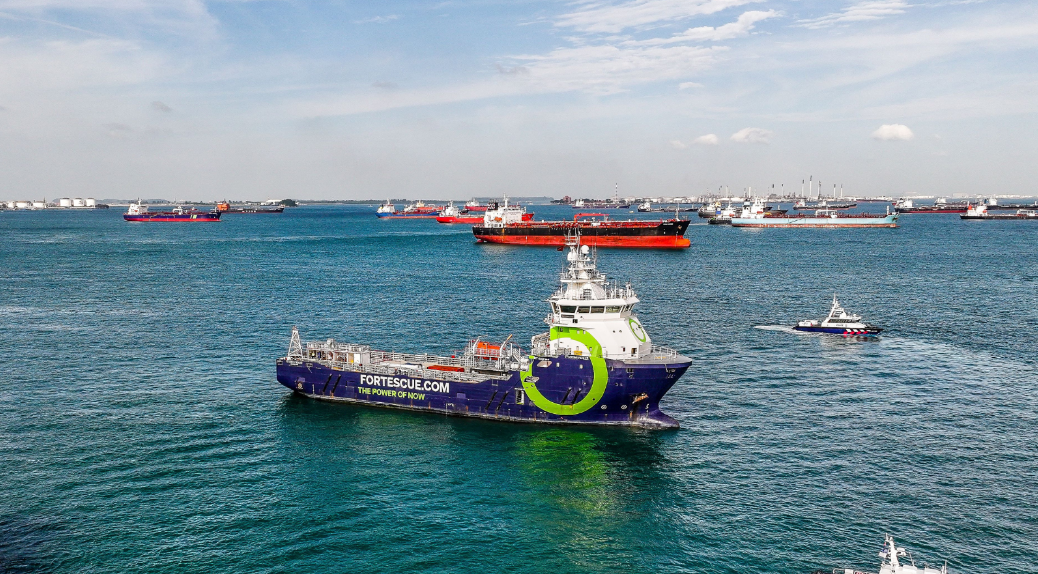Fortescue, with the support of the Maritime and Port Authority of Singapore (MPA), government agencies, research institutes, and industry partners, has successfully conducted the world’s first use of ammonia, in combination with diesel in the combustion process, as a marine fuel onboard the Singapore-flagged ammonia-powered vessel, the Fortescue Green Pioneer, in the Port of Singapore.

In preparation for the vessel’s operations in Singapore, Hazard Identification Study and Hazard and Operability Study workshops were jointly organised by MPA, Fortescue, Vopak, research institutes, and industry partners to identify the potential risks during fuel transfer and engine trials and to develop the necessary prevention, control, and mitigation measures.
The Fortescue Green Pioneer started its journey towards becoming the world’s first ocean-going ammonia-powered vessel in 2022 when Fortescue successfully converted a four-stroke engine to run on ammonia, in combination with diesel, at its land-based testing facility in Perth, Western Australia.
Following the success of the land-based testing, conversion work commenced on the vessel at Seatrium’s Benoi yard from July 2023. This included the installation of the gas fuel delivery system, safety systems and infrastructure, and the successful conversion of two of the vessel’s four engines to enable the use of ammonia, combined with diesel in the combustion process, to power the vessel. The two remaining engines onboard the Fortescue Green Pioneer will operate on conventional fuels when required.
In December 2023, the vessel sailed from Singapore to the Middle East and was showcased at the UN Framework Convention on Climate Change and associated meetings (COP28/CMP18/CMA5) in Dubai, United Arab Emirates. World leaders, industry captains and members of international organisations were among the guests hosted on the vessel.
Trainings , including gas-specific Hazardous Materials emergency responses, and MPA-led safety drills, were also conducted to assess the operational readiness and preparedness of crew during an incident. All crew attained the necessary proficiencies on the new enhanced procedures prior to the conduct of the trials.
An ammonia plume model was jointly developed by the Agency for Science, Technology and Research’s Institute of High Performance Computing (A*STAR’s IHPC), Nanyang Technological University’s Maritime Energy and Sustainable Development Centre of Excellence (MESD), the Technology Centre for Offshore and Marine, Singapore (TCOMS), and the National University of Singapore’s Tropical Marine Science Institute (TMSI) to determine the safety envelope, model the dispersion of an ammonia plume in an event of an incident, and to support the safety and incident response planning. The model, which accounted for the Fortescue Green Pioneer’s vessel and engine design parameters, behaviour of ammonia within Singapore’s tropical climate, sea current conditions, and surrounding vessels, infrastructure, and geometries, was used to guide the operations. It will be continually enhanced as operations for new maritime fuels scale up in the Port of Singapore.
The fuel trial was conducted over a period of seven weeks and included rigorous testing of the Fortescue Green Pioneer’s ammonia storage systems, associated piping, gas fuel delivery system, retrofitted engines, and seaworthiness. The tests were conducted in phases to ensure safe port operations and safety for crew members and engineers who have completed a series of rigorous training sessions since October 2023. As part of the safety protocols for the conduct of these tests, crew members also donned personal protection equipment such as chemical protection suits, nitrile chemical gloves, rubber boots, positive pressure mask and hood, and portable gas detectors for the relevant operations.
The two four-stroke retrofitted engines served as proxy for the commercialisation of ammonia-fueled marine engines under development globally. The post-combustion nitrogen oxide (NOx) levels met the local air quality standard, while efforts to reduce the pilot fuel for combustion ignition and nitrous oxide (N2O) emissions post-combustion will continue as more ammonia-fueled marine engines and low-carbon ammonia sources become available.
Fortescue engaged DNV to be part of the innovation process from the very early stages of this project. The Fortescue Green Pioneer’s ammonia fuel systems and engine conversion received class approval by DNV based on DNV’s Technology Qualification process to ensure that the new technology and systems fitted onboard, which were not covered under existing regulations, will function within specified limits and acceptable levels of confidence.
Prior to issuance of the relevant statutory certificates by DNV on behalf of the Singapore Registry of Ships, MPA worked closely with DNV and Fortescue on the technical assessment of the vessel and the approval process of the vessel’s ammonia safety systems and design under the SOLAS regulation on alternative design and arrangements.
Following the world’s first ship-to-containership methanol bunkering operation in Singapore in July 2023 and the implementation of digital bunkering operations from November 2023, the successful conduct of this ammonia fuel trial on board the Fortescue Green Pioneer marks a significant milestone in Singapore’s multi-fuel bunkering capability development to support the digitalisation, decarbonisation, and manpower development for international shipping. The collective support provided for such trials also demonstrates the facilitative regulatory environment, and the strong research and tripartite ecosystem in Singapore to support the conduct of trials and scale-up operations for new maritime fuels.


